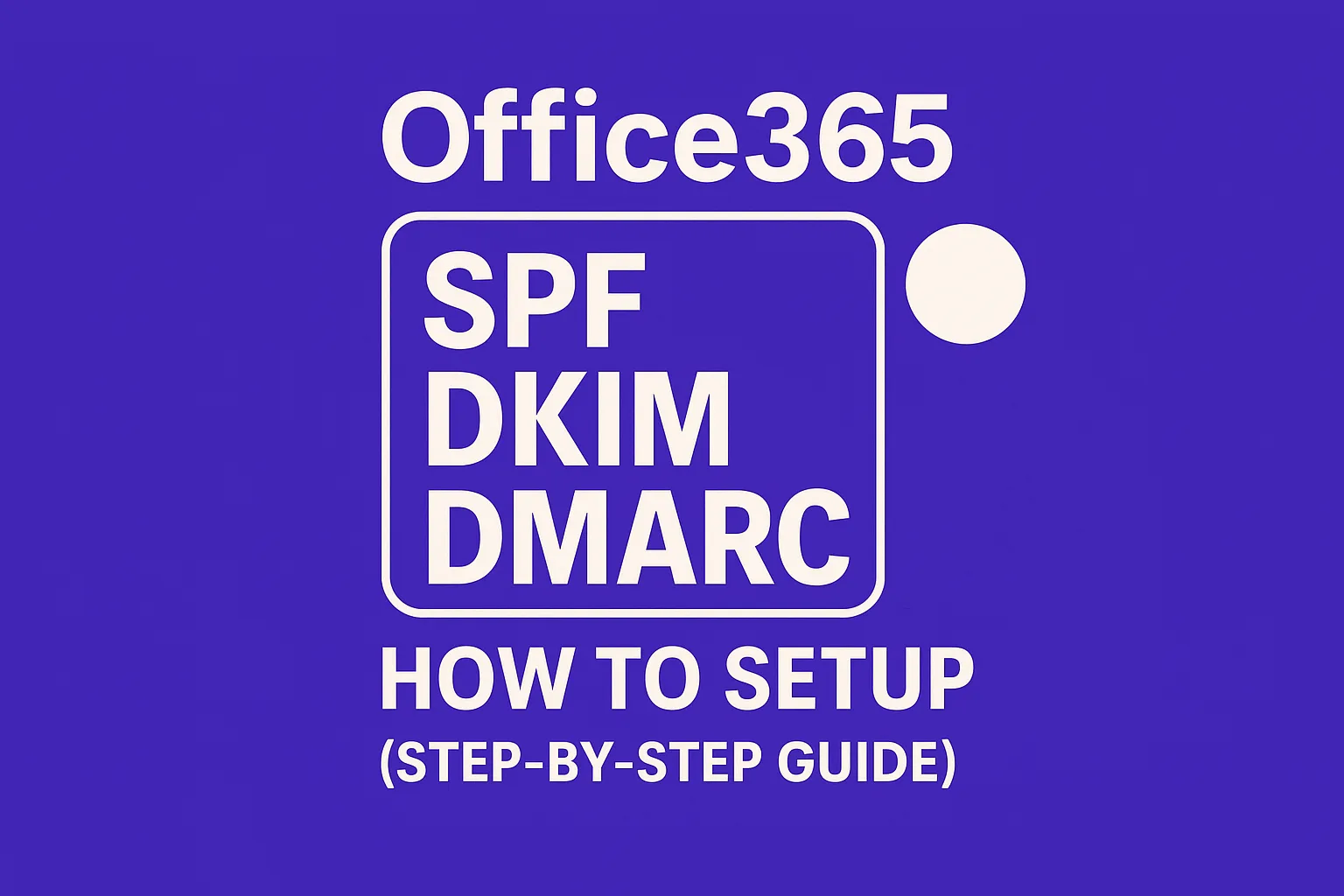Fix Gmail Error: 550 5.7.26 Unauthenticated email is not accepted – (Expert Step-by-Step Guide)

Gmail error 550 5.7.26 meaning
You sent an email, but Gmail bounced it back with the error 550 5.7.26 Unauthenticated email is not accepted. This message means Gmail was unable to verify you as a legitimate sender. It checked for SPF or DKIM that match your From domain, but didn’t find a valid result, so DMARC validation failed, and Gmail rejected your message.
Gmail now requires authentication on every email you send. For bulk senders, adding a DMARC record is also required. As of now, this is a basic requirement for getting your messages delivered. The good news? You can resolve this in just a few steps.
Quick checklist before you edit DNS
- Open the bounce message or the original email’s headers.
- Look for
Authentication-Resultsand notespf=,dkim=, anddmarc=statuses. - If both SPF and DKIM show fail or none, this explains the 5.7.26 error.
- Identify which domain appears in the visible
From:address. - Determine who actually sent the email: your own server or an ESP/CRM.
If you need a refresher on these concepts, check out this clear guide: SPF, DKIM, and DMARC explained simply. It connects the dots without the usual jargon.
Step-by-step fix for 550 5.7.26
1) Publish a single, correct SPF record
SPF authorizes which servers can send emails from your domain. You must have only one SPF record, multiple records will cause validation to fail.
- List all the platforms that send email for your domain.
- Create one SPF record that includes every sender.
- Ensure your SPF has fewer than 10 DNS lookups by removing anything unnecessary.
- End the record with
-allor~all. Once you’re confident, use-allfor stricter enforcement.
Example:
v=spf1 include:_spf.google.com include:sendgrid.net -allAlignment tip: SPF checks the return-path (MAIL FROM), not just the visible From header. With most ESPs, you need to set a custom bounce/return-path on your domain. Otherwise, SPF may pass but not align, causing DMARC to fail.
2) Enable DKIM with your From domain
DKIM signs your messages, so Gmail knows the email’s integrity and domain source. Use 2048-bit keys when possible, and make sure you sign with the same domain as in your visible From address.
- Generate a DKIM key in your mail system or ESP.
- Publish the TXT record at the correct selector host.
- Turn on DKIM signing in your sending platform.
Example format:
Name: selector1._domainkey.example.com Type: TXTValue: v=DKIM1; k=rsa; p=[your-public-key]Once it’s propagated, test by sending to Gmail and making sure dkim=pass appears. If you’re signing as a different domain, set up a custom signing domain so alignment is correct.
3) Add a DMARC record and start in monitor mode
DMARC tells email providers how to handle failures and where to send reports. Start with p=none to gather data, and move to quarantine or reject after you’ve verified alignment is solid.
Publish at _dmarc.example.com:
v=DMARC1; p=none; rua=mailto:dmarc@yourdomain.com; ruf=mailto:dmarc@yourdomain.com; fo=1; aspf=r; adkim=r; pct=100Relaxed alignment (r) is best while you’re fixing possible sending issues. Later on, switch to strict (s) if you want even tighter control over your domain’s security.
4) Make SPF or DKIM align with your From domain
DMARC will only pass if at least one (SPF or DKIM) is both “pass” and aligned. SPF relies on the return-path domain, while DKIM depends on the d= domain in the DKIM signature.
- If you use an ESP, set up both a custom return-path and a custom DKIM domain.
- If you use your own server, make sure the MAIL FROM domain is your own domain, not a generic hostname.
- Keep the visible From on the same organizational domain throughout your systems.
Special cases that still trigger 5.7.26
Forwarding breaks SPF
Email forwarding rewrites the path, often breaking SPF. DKIM typically still passes. If both fail, DMARC fails. Ask the forwarder to support SRS. For mailing lists, enable From rewriting or ARC support.
Multiple SPF records
This is a common issue. Merge all SPF entries into a single record on your domain. Having more than one causes automatic failure.
Sending from a CRM or helpdesk
Don’t send as you@yourdomain.com
using a vendor’s default domain. Instead, verify your domain inside their platform and publish their DKIM and return-path CNAMEs on your DNS.
Subdomains and the DMARC sp= tag
If you send from subdomains such as news.example.com, set the policy you want for subdomains using the sp= tag, for example, sp=quarantine or sp=reject when you’re ready.
How to test that the fix worked
- Send a new test message to a Gmail inbox.
- Open the message and click View original.
- Make sure you see
SPF: PASSandDKIM: PASS. At least one of them should show as aligned. - Check that
DMARC: PASSappears. This means the 5.7.26 issue is resolved.
You can also run a live check in mailX, a mail testing tool. It examines SPF, DKIM, DMARC, and alignment, useful for quick sanity checks across all your sending systems.
DNS tips that save hours
- Allow extra time for DNS records to propagate, sometimes a few hours.
- Always use 2048-bit DKIM keys unless your host doesn’t support them.
- Keep your SPF includes minimal by removing any unused vendor entries.
- Set up reverse DNS for all dedicated SMTP IP addresses.
- Use a consistent visible From domain across every tool or service you use.
Stop repeat failures with a simple playbook
- List every system that sends mail for your domain.
- Assign each system its own DKIM selector.
- Set a unique return-path for each sending vendor.
- Monitor DMARC reports every week, not just once a year.
- Warm up any new domains and IPs slowly to build a positive sending reputation.
The mailwarm feature in mailX simulates positive mail exchanges, helping you build a trustworthy reputation curve. The mailwarm feature in mailX won’t fix missing authentication, but it helps once your DNS is correctly set up.
Troubleshooting script you can follow today
- Check your headers: if
spf=failanddkim=fail, correct both immediately. - If SPF passes but DMARC fails, ensure your return-path domain is aligned correctly.
- If DKIM passes but DMARC fails, be sure you’re signing with the From domain.
- If DMARC is set to
p=reject, consider switching top=nonewhile testing. - Resend and confirm DMARC pass status in Gmail.
I view the error 5.7.26 as a guide indicating where the problem lies, not as a major issue.
When the error persists
If issues continue, check for any sending infrastructure you might have missed. Ensure that all SMTP hosts and plugins are updated and correctly configured, as outdated settings can result in email delivery issues. DMARC reports are helpful for quickly spotting sources that aren’t properly configured.
If you send newsletters or transactional emails at scale, schedule regular audits. SPF sprawl and expired DKIM keys can sneak in over time. A brief review keeps Gmail deliveries smooth.
Wrap-up
Gmail returns a 550 5.7.26 error when it cannot authenticate you. The solution is clear: set up SPF, enable DKIM, and make sure at least one aligns with your From domain. Add DMARC, monitor what’s reported, and keep your sending setup tidy. Follow these steps, and your emails will stop bouncing for this reason.
If you want a friendly second set of eyes or need hands-on support getting records and alignment straight, you can get help from deliverability specialists at mailadept. They handle complex setups and reputation fixes every day.
FAQ
What does Gmail error 550 5.7.26 signify?
Gmail error 550 5.7.26 indicates that your email lacks proper authentication, failing to verify you as the sender. Without SPF or DKIM authorization, DMARC policies will cause your emails to bounce.
Why is having multiple SPF records a problem?
More than one SPF record results in automatic validation failure, confusing mail servers about which record to follow. Consolidate them into one to prevent deliverability issues.
How can DKIM affect email integrity?
DKIM assures email integrity by allowing the recipient to verify that an email came from the declared source. Opt for 2048-bit keys to enhance security but ensure domain alignment for DMARC compliance.
Do forwarding services impact SPF?
Yes, forwarding can break SPF by altering the email path, leading to SPF failure. Implement SRS or enable ARC to stabilize the authentication chain and protect integrity.
What if DMARC reports provide incomplete alignment details?
Analyzing DMARC reports helps you ascertain alignment issues, but incomplete data can be due to overlooked senders. Regular audits and system updates prevent sneaky SPF sprawl and expired DKIM keys.
How should subdomains handle DMARC policies?
Subdomains need explicit DMARC policies using the sp= tag, turning to either quarantine or reject to address vulnerabilities. Ensure your policies evolve as your email practices mature.
Can using a CRM affect my domain's deliverability?
Sending emails from a CRM without verifying your domain or exceeding SPF lookups is a rookie mistake. Properly publish DKIM and return-path CNAMEs to align email integrity with your brand.
Is switching DMARC to p=none beneficial?
Starting with p=none in DMARC lets you gather data without rejecting emails, crucial for understanding sender alignment before escalating to stricter measures. It’s a strategic retreat, not a permanent fix.








